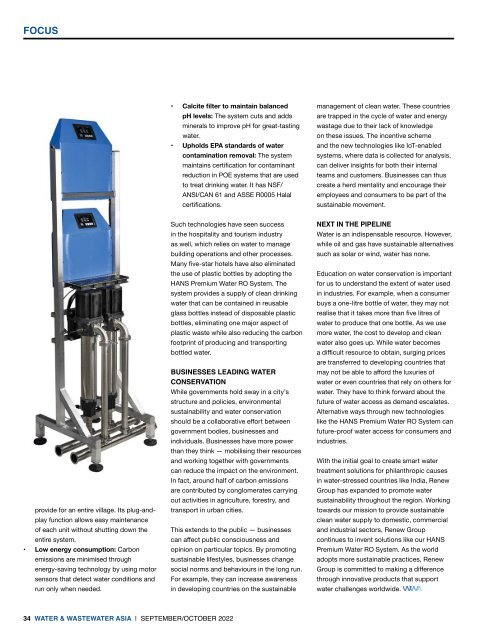Water & Wastewater Asia September/October 2022
Water & Wastewater Asia is an expert source of industry information, cementing its position as an indispensable tool for trade professionals in the water and wastewater industry. As the most reliable publication in the region, industry experts turn this premium journal for credible journalism and exclusive insight provided by fellow industry professionals. Water & Wastewater Asia incorporates the official newsletter of the Singapore Water Association (SWA).
Water & Wastewater Asia is an expert source of industry information, cementing its position as an indispensable tool for trade professionals in the water and wastewater industry. As the most reliable publication in the region, industry experts turn this premium journal for credible journalism and exclusive insight provided by fellow industry professionals. Water & Wastewater Asia incorporates the official newsletter of the Singapore Water Association (SWA).
Create successful ePaper yourself
Turn your PDF publications into a flip-book with our unique Google optimized e-Paper software.
FOCUS<br />
• Calcite filter to maintain balanced<br />
pH levels: The system cuts and adds<br />
minerals to improve pH for great-tasting<br />
water.<br />
• Upholds EPA standards of water<br />
contamination removal: The system<br />
maintains certification for contaminant<br />
reduction in POE systems that are used<br />
to treat drinking water. It has NSF/<br />
ANSI/CAN 61 and ASSE R0005 Halal<br />
certifications.<br />
management of clean water. These countries<br />
are trapped in the cycle of water and energy<br />
wastage due to their lack of knowledge<br />
on these issues. The incentive scheme<br />
and the new technologies like IoT-enabled<br />
systems, where data is collected for analysis,<br />
can deliver insights for both their internal<br />
teams and customers. Businesses can thus<br />
create a herd mentality and encourage their<br />
employees and consumers to be part of the<br />
sustainable movement.<br />
provide for an entire village. Its plug-andplay<br />
function allows easy maintenance<br />
of each unit without shutting down the<br />
entire system.<br />
• Low energy consumption: Carbon<br />
emissions are minimised through<br />
energy-saving technology by using motor<br />
sensors that detect water conditions and<br />
run only when needed.<br />
Such technologies have seen success<br />
in the hospitality and tourism industry<br />
as well, which relies on water to manage<br />
building operations and other processes.<br />
Many five-star hotels have also eliminated<br />
the use of plastic bottles by adopting the<br />
HANS Premium <strong>Water</strong> RO System. The<br />
system provides a supply of clean drinking<br />
water that can be contained in reusable<br />
glass bottles instead of disposable plastic<br />
bottles, eliminating one major aspect of<br />
plastic waste while also reducing the carbon<br />
footprint of producing and transporting<br />
bottled water.<br />
BUSINESSES LEADING WATER<br />
CONSERVATION<br />
While governments hold sway in a city’s<br />
structure and policies, environmental<br />
sustainability and water conservation<br />
should be a collaborative effort between<br />
government bodies, businesses and<br />
individuals. Businesses have more power<br />
than they think — mobilising their resources<br />
and working together with governments<br />
can reduce the impact on the environment.<br />
In fact, around half of carbon emissions<br />
are contributed by conglomerates carrying<br />
out activities in agriculture, forestry, and<br />
transport in urban cities.<br />
This extends to the public — businesses<br />
can affect public consciousness and<br />
opinion on particular topics. By promoting<br />
sustainable lifestyles, businesses change<br />
social norms and behaviours in the long run.<br />
For example, they can increase awareness<br />
in developing countries on the sustainable<br />
NEXT IN THE PIPELINE<br />
<strong>Water</strong> is an indispensable resource. However,<br />
while oil and gas have sustainable alternatives<br />
such as solar or wind, water has none.<br />
Education on water conservation is important<br />
for us to understand the extent of water used<br />
in industries. For example, when a consumer<br />
buys a one-litre bottle of water, they may not<br />
realise that it takes more than five litres of<br />
water to produce that one bottle. As we use<br />
more water, the cost to develop and clean<br />
water also goes up. While water becomes<br />
a difficult resource to obtain, surging prices<br />
are transferred to developing countries that<br />
may not be able to afford the luxuries of<br />
water or even countries that rely on others for<br />
water. They have to think forward about the<br />
future of water access as demand escalates.<br />
Alternative ways through new technologies<br />
like the HANS Premium <strong>Water</strong> RO System can<br />
future-proof water access for consumers and<br />
industries.<br />
With the initial goal to create smart water<br />
treatment solutions for philanthropic causes<br />
in water-stressed countries like India, Renew<br />
Group has expanded to promote water<br />
sustainability throughout the region. Working<br />
towards our mission to provide sustainable<br />
clean water supply to domestic, commercial<br />
and industrial sectors, Renew Group<br />
continues to invent solutions like our HANS<br />
Premium <strong>Water</strong> RO System. As the world<br />
adopts more sustainable practices, Renew<br />
Group is committed to making a difference<br />
through innovative products that support<br />
water challenges worldwide.<br />
34 WATER & WASTEWATER ASIA | SEPTEMBER/OCTOBER <strong>2022</strong>


















